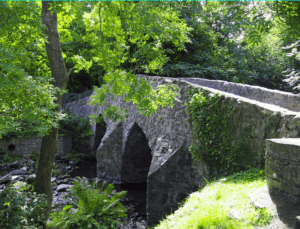To be honest, there isn’t a lot left of Rushen Abbey, but they make the most of it. There is an excellent visitor centre with a lot of information about the abbey and the monks. Kids can dress up as monks and there is a huge egg timer for them to use to make sure they are spending enough time on saying their prayers… There are also a variety of kid’s activities (grown ups can have a go too!) including building an arch which isn’t as easy as it looks.
The ruins are set in extensive grounds, which are a lovely a lovely setting for weddings. This is a place to drop out on a warm summer day and dream about the tea dances held here between the wars….
Land to build Rushen Abbey was gifted by King Olaf I in 1134, who believed this would enhance his spiritual standing and reputation as a good Christian ruler (and also short track his progress to heaven after his death). The abbey was founded by monks from Furness Abbey in Cumbria and its layout is typical of all Cistercian Abbeys. Being close to Castle Rushen offered some protection in times of trouble. It was a target of raids during the C13th and C14th and the monks built a boundary wall with towers around the abbey. All that remains now is an ivy covered tower.
The earliest buildings would have been made of wood to be replaced later by stone. Monks and lay brothers helped build the abbey as part of their daily labour. The abbey was completed by 1257. Many of the abbots became Bishops of Sodor (the Isle of Man and the Hebrides). The abbey also housed the main body of knowledge and literacy for the Island. The Chronicles of the Kings of Mann and the Isles, recording Manx history from 1066-1316, was probably written by the monks at Rushen Abbey during the 13th and early 14th centuries. A copy is in the “House of Manannan”:http://wasleys.org.uk/eleanor/man/central/manannan/index.html in Peel.
The Abbot was deputy governor of the island, holding considerable political and economic power. The Abbey held extensive estates from Derbyhaven to South Barrule, which included most of the productive agricultural land on the island. The abbey was exempt from all tolls and taxes and was responsible for much of the trade within the island, as well as export trade. It had warehouses in both Castletown and Derbyhaven. All roads led to Ballasalla. Monk’s Bridge was built around 1350 to cross the Silverburn.
Monks grew crops for their own use as well as for guests and as charity for the poor. They caught fish and kept livestock. They were good sheep farmers, exporting wool across Europe. They controlled grazing, fishing and mineral rights for lead, silver and iron ore.
The Abbey was dissolved in 1540 and the abbot and monks were expelled. Not only did this give Henry control over the church, selling assets also helped fund expenditure on his military campaigns. The buildings were stripped of everything of value and the stone was used as building material. Only fragments of the abbot’s lodgings and a single tower survived, the site eventually being taken over and run by a local family as a working farm. Much of the stone appears to have been used in the construction of a nearby house,which was the home of Deemster Moore, who held his court here twice a week.
The house became a boarding school for girls in 1847, when the redoubtable Stowell sisters moved their school here from Douglas. They felt that a country residence was ‘preferable for the purposes of education’. The school closed twenty years later and became a hotel.
Around that time a jam factory and fruit bottling business began in the abbey grounds using fruit grown there.
By the 1900s, the grounds with their fruit bushes, apple trees and flowers became a popular tourist attraction. Visitors were charged 6d to enter and enjoy such attractions as putting and bowling green, a dance floor with live music, peacocks as well as strawberry and cream teas.
By the 1980’s the hotel had closed and a steakhouse cafe and a nightclub were built. These closed in the 1990s by which time the grounds were described as a ‘national disgrace’. A private developer announced plans for a big hotel complex but, after local furore, the site was bought by the Manx Government and Manx National Heritage. Deemster Moore’s house reopened as a restaurant.
All that remains of the abbey is the church tower, the abbot’s lodgings (now part of the exhibition), the chapter house which was converted to a folly in the C19th and a few foundations. Part of the gardens have been planted as a monastic garden growing plants and herbs that might have been grown by the monks. Beyond then is a pond and wildlife area developed on an old watercourse of the Silverburn.
When you have finished visiting the abbey, walk along the Silverburn to find the old packhorse bridge built by the mons. This gives access to a walk up the Silverburn Glen.
Very much a worthwhile day out!
There is more information and pictures “here.”:http://wasleys.org.uk/eleanor/man/south/rushen_abbey/index.html








